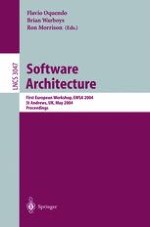The last decade has been one of great progress in the field of software architecture research and practice. Software architecture has emerged as an important subdis- pline of software engineering. A key aspect of the design of any software system is its architecture, i. e. the fundamental organization of a system embodied in its com- nents, their relationships to each other, and to the environment, and the principles guiding its design and evolution (as defined in the Recommended Practice for Arc- tectural Description of Software-Intensive Systems -- IEEE Std 1471-2000). - The First European Workshop on Software Architecture (EWSA 2004) provided an international forum for researchers and practitioners from academia and industry to discuss a wide range of topics in the area of software architecture, and to jointly f- mulate an agenda for future research in this field. EWSA 2004 distinguished among three types of papers: research papers (which describe authors’ novel research work), experience papers (which describe real-world experiences related to software architectures), and position papers (which present concise arguments about a topic of software architecture research or practice). The Program Committee selected 19 papers (9 research papers, 4 experience - pers, and 6 position papers) out of 48 submissions from 16 countries (Australia, B- zil, Canada, Chile, Finland, France, Germany, Italy, Japan, Korea, The Netherlands, Spain, Switzerland, Turkey, UK, USA). All submissions were reviewed by three members of the Program Committee.
